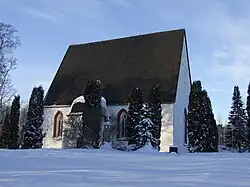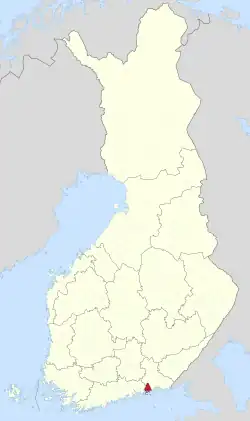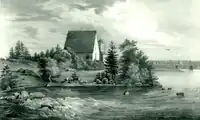Pyhtää
Pyhtää (Swedish: Pyttis) is a municipality of Finland. It is located in the Kymenlaakso region, 27 kilometres (17 mi) west of the city of Kotka.
Pyhtää
Pyhtää – Pyttis | |
|---|---|
Municipality | |
| Pyhtään kunta Pyttis kommun | |
 The medieval St. Henry's church | |
 Coat of arms | |
 Location of Pyhtää in Finland | |
| Coordinates: 60°30′N 026°33′E | |
| Country | |
| Region | Kymenlaakso |
| Sub-region | Kotka-Hamina sub-region |
| Founded | ca. 1380 |
| Government | |
| • Municipality manager | Olli Ikonen |
| Area (2018-01-01)[1] | |
| • Total | 780.96 km2 (301.53 sq mi) |
| • Land | 324.72 km2 (125.38 sq mi) |
| • Water | 456.24 km2 (176.16 sq mi) |
| • Rank | 228th largest in Finland |
| Population (2023-09-19)[2] | |
| • Total | 5,094 |
| • Rank | 165th largest in Finland |
| • Density | 15.69/km2 (40.6/sq mi) |
| Population by native language | |
| • Finnish | 88.4% (official) |
| • Swedish | 6.8% |
| • Others | 4.8% |
| Population by age | |
| • 0 to 14 | 16.2% |
| • 15 to 64 | 56.9% |
| • 65 or older | 26.9% |
| Time zone | UTC+02:00 (EET) |
| • Summer (DST) | UTC+03:00 (EEST) |
| Climate | Dfb |
| Website | www.pyhtaa.fi |
Overview
The municipality has a population of 5,094 (19 September 2023)[2] and covers an area of 780.96 square kilometres (301.53 sq mi) of which 456.24 km2 (176.16 sq mi) is water.[1] The population density is 15.69 inhabitants per square kilometre (40.6/sq mi).

The medieval church (as opposed to the municipality) is situated in the village of Itäkirkonkylä ("East Church Village"). During the Reformation, the rather beautiful and moving pictures on the walls were whitewashed over. Some years ago, they were rediscovered and the whitewash removed. The village lies just to the East of the westernmost tributary of the Kymi River and was at one time on the border between Russia and Sweden established by the Treaty of Åbo in 1743. Indeed, on the Western side of the river is a municipality called Ruotsinpyhtää ("Swedish Pyhtää") known as Strömfors in Swedish.
The municipality is bilingual with 88.4% speaking Finnish, 6.8% Swedish and 4.8% other languages as their first language.[3]
In the 1980s, salmon soup, salted herrings and clot soup (klimppisoppa) were named as Pyhtää's traditional parish dishes.[5]
Villages
- Heinlahti (Swedish: Heinlax)
- Hinkaböle
- Hirvikoski (earlier Österhirvikoski)
- Itäkirkonkylä (Swedish: Österkyrkoby)
- Itämyllynkylä (Swedish: Österkvarnby)
- Kaunissaari (Swedish: Fagerö)
- Kiviniemi (Swedish: Stensnäs, earlier Lillkuppis)
- Loosari (Swedish: Klåsarö)
- Länsikirkonkylä (Swedish: Västerkyrkoby)
- Länsikylä (Swedish: Västerby, earlier Västerkuppis)
- Länsimyllynkylä (Swedish: Västerkvarnby)
- Malmi, Pyhtää (Swedish: Malm)
- Munapirtti (Swedish: Mogenpört)
- Pirtnuora (Swedish: Pörtnor)
- Siltakylä (Swedish: Broby, earlier Storkuppis)
- Suur-Ahvenkoski (Swedish: Storabborrfors)
- Tuuski (Swedish: Tuskas; de jure a part of Munapirtti)
- Purola
Twinnings
 Haljala Parish, Estonia (since 1989)[6]
Haljala Parish, Estonia (since 1989)[6]
References
- "Area of Finnish Municipalities 1.1.2018" (PDF). National Land Survey of Finland. Retrieved 30 January 2018.
- "Finland's preliminary population figure was 5,587,841 at the end of August 2023". StatFin. Statistics Finland. Retrieved 30 September 2023.
- "Demographic Structure by area as of 31 December 2022". Statistics Finland's PX-Web databases. Statistics Finland. Retrieved 6 September 2023.
- "Population according to age (1-year) and sex by area and the regional division of each statistical reference year, 2003–2020". StatFin. Statistics Finland. Retrieved 2 May 2021.
- Jaakko Kolmonen (1988). Kotomaamme ruoka-aitta: Suomen, Karjalan ja Petsamon pitäjäruoat (in Finnish). Helsinki: Patakolmonen. p. 102–103. ISBN 951-96047-3-1.
- "Sõprusvallad" (in Estonian). Haljala vald. Retrieved 4 May 2012.
External links
 Media related to Pyhtää at Wikimedia Commons
Media related to Pyhtää at Wikimedia Commons- Municipality of Pyhtää – Official website (in Finnish and Swedish)
- Map of Pyhtää
